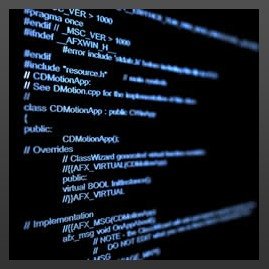[Coursera] Mathematics for Machine Learning: Linear Algebra
In this course on Linear Algebra we look at what linear algebra is and how it relates to vectors and matrices. Then we look through what vectors and matrices are and how to work with them, including the knotty problem of eigenvalues and eigenvectors, and how to use these to solve problems. Finally we look at how to use these to do fun things with datasets - like how to rotate images of faces and how to extract eigenvectors to look at how the Pagerank algorithm works. Since we're aiming at data-driven applications, we'll be implementing some of these ideas in code, not just on pencil and paper. Towards the end of the course, you'll write code blocks and encounter Jupyter notebooks in Python, but don't worry, these will be quite short, focussed on the concepts, and will guide you through if you’ve not coded before.
At the end of this course you will have an intuitive understanding of vectors and matrices that will help you bridge the gap into linear algebra problems, and how to apply these concepts to machine learning.
SKILLS YOU WILL GAIN
Eigenvalues And EigenvectorsBasis (Linear Algebra)Transformation MatrixLinear Algebra
Критерий завершения
прошла курс, получила серт
-
Introduction to Linear Algebra and to Mathematics for Machine Learning
In this first module we look at how linear algebra is relevant to machine learning and data science. Then we'll wind up the module with an initial introduction to vectors. Throughout, we're focussing on developing your mathematical intuition, not of crunching through algebra or doing long pen-and-paper examples. For many of these operations, there are callable functions in Python that can do the adding up - the point is to appreciate what they do and how they work so that, when things go wrong or there are special cases, you can understand why and what to do.
-
Introduction: Solving data science challenges with mathematics
-
Motivations for linear algebra
-
Getting a handle on vectors
-
Operations with vectors
-
Summary
-
About Imperial College & the team
-
How to be successful in this course
-
Grading policy
-
Additional readings & helpful references
-
Exploring parameter space
-
Solving some simultaneous equations
-
Doing some vector operations
-
-
Vectors are objects that move around space
In this module, we look at operations we can do with vectors - finding the modulus (size), angle between vectors (dot or inner product) and projections of one vector onto another. We can then examine how the entries describing a vector will depend on what vectors we use to define the axes - the basis. That will then let us determine whether a proposed set of basis vectors are what's called 'linearly independent.' This will complete our examination of vectors, allowing us to move on to matrices in module 3 and then start to solve linear algebra problems.
-
Introduction to module 2 - Vectors
-
Modulus & inner product
-
Cosine & dot product
-
Projection
-
Changing basis
-
Basis, vector space, and linear independence
-
Applications of changing basis
-
Summary
-
Dot product of vectors
-
Changing basis
-
Linear dependency of a set of vectors
-
Vector operations assessment
-
-
Matrices in Linear Algebra: Objects that operate on Vectors
Now that we've looked at vectors, we can turn to matrices. First we look at how to use matrices as tools to solve linear algebra problems, and as objects that transform vectors. Then we look at how to solve systems of linear equations using matrices, which will then take us on to look at inverse matrices and determinants, and to think about what the determinant really is, intuitively speaking. Finally, we'll look at cases of special matrices that mean that the determinant is zero or where the matrix isn't invertible - cases where algorithms that need to invert a matrix will fail.
-
Matrices, vectors, and solving simultaneous equation problems
-
How matrices transform space
-
Types of matrix transformation
-
Composition or combination of matrix transformations
-
Solving the apples and bananas problem: Gaussian elimination
-
Going from Gaussian elimination to finding the inverse matrix
-
Determinants and inverses
-
Summary
-
Using matrices to make transformations
-
Solving linear equations using the inverse matrix
-
Notebook: Identifying special matrices
-
Programming Assignment: Identifying special matrices 30 min
-
-
Matrices make linear mappings
In Module 4, we continue our discussion of matrices; first we think about how to code up matrix multiplication and matrix operations using the Einstein Summation Convention, which is a widely used notation in more advanced linear algebra courses. Then, we look at how matrices can transform a description of a vector from one basis (set of axes) to another. This will allow us to, for example, figure out how to apply a reflection to an image and manipulate images. We'll also look at how to construct a convenient basis vector set in order to do such transformations. Then, we'll write some code to do these transformations and apply this work computationally.
-
Introduction: Einstein summation convention and the symmetry of the dot product
-
Matrices changing basis
-
Doing a transformation in a changed basis
-
Orthogonal matrices
-
The Gram–Schmidt process
-
Example: Reflecting in a plane
-
Non-square matrix multiplication
-
Example: Using non-square matrices to do a projection
-
Notebook: Gram-Schmidt process
-
Notebook: Reflecting Bear
-
Programming Assignment: Gram-Schmidt Process
-
Programming Assignment: Reflecting Bear
-
-
Eigenvalues and Eigenvectors: Application to Data Problems
Eigenvectors are particular vectors that are unrotated by a transformation matrix, and eigenvalues are the amount by which the eigenvectors are stretched. These special 'eigen-things' are very useful in linear algebra and will let us examine Google's famous PageRank algorithm for presenting web search results. Then we'll apply this in code, which will wrap up the course.
-
Welcome to module 5
-
What are eigenvalues and eigenvectors?
-
Special eigen-cases
-
Calculating eigenvectors
-
Changing to the eigenbasis
-
Eigenbasis example
-
Introduction to PageRank
-
Summary
-
Wrap up of this linear algebra course
-
Did you like the course? Let us know!
-
Selecting eigenvectors by inspection
-
Characteristic polynomials, eigenvalues and eigenvectors
-
Diagonalisation and applications
-
Eigenvalues and eigenvectors
-
- 3916
- 21 ноября 2019, 05:57
Не пропустите новые записи!
Подпишитесь на цель и следите за ее достижением



